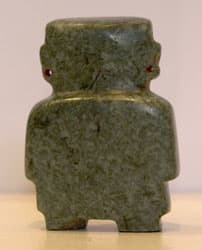Teotihuacan Jade Figurine, 200 CE - 600 CE
Jade
1.5 x 2.125
CK.0781
Teotihuacan is referred to as the city of the gods. By 600 A.D. it was the sixth largest city in the world. Situated in a temperate, fertile basin its fame...
Teotihuacan is referred to as the city of the gods. By 600 A.D. it was the sixth largest city in the world. Situated in a temperate, fertile basin its fame spread as quickly as its prosperity, with well-established trade routes and a culture that is still impressive today. A booming economy gave rise to an urban elite that in turn fostered intellectual activity, monumental building and the belief Teotihuacan was where the cosmos and the present cycle of life began. The concept of monumentality can apply not only to great architectural structures such as the Pyramid of the Sun, but also to much smaller objects which have an intensity that makes them larger than life.
From 250 A.D. onwards, objects made from clay increased dramatically, serving a wide variety of purposes and functions. Most impressive are sculptures representing host figurines or "puppets". Both categories were found in burials and caches. The host figurine commemorated important events within the city of Teotihuacan and other parts of Mesoamerica, portraying individuals of different rank and status (such as soldiers, merchants or bureaucrats), and occasionally divinities. Puppets, or articulated figurines, constitute a fascinating group of clay objects with moveable limbs. Although the great civilization of Teotihuacan met its untimely end around 700 A.D., by the hand of invaders, the creative spirit of the people lives on in their enduring artist creations and spectacular ruins.
From 250 A.D. onwards, objects made from clay increased dramatically, serving a wide variety of purposes and functions. Most impressive are sculptures representing host figurines or "puppets". Both categories were found in burials and caches. The host figurine commemorated important events within the city of Teotihuacan and other parts of Mesoamerica, portraying individuals of different rank and status (such as soldiers, merchants or bureaucrats), and occasionally divinities. Puppets, or articulated figurines, constitute a fascinating group of clay objects with moveable limbs. Although the great civilization of Teotihuacan met its untimely end around 700 A.D., by the hand of invaders, the creative spirit of the people lives on in their enduring artist creations and spectacular ruins.
